Many wellness tips based around general nutrition follow the same topics and themes time and time again:
- Eat your (fruits and) vegetables
- Exercise regularly
- Drink more water (and less sugary drinks!)
These simple concepts bear repeating because they are sound advice, yet so hard to instill and maintain! Would it shock the public to know that The American Institute for Cancer Research (AICR) has determined that nearly half of cancer cases in the United States alone could be prevented by changing our everyday habits? More specifically, the AICR believes 1/3 of the most common cancers, about 358,000 cases, would never happen if only Americans moved more, weighed less, and had better, healthier eating habits. When factoring in sun protection and not smoking, that 1/3 figure increases to the aforementioned 1/2 preventative figure.
Hormones and Nutrition
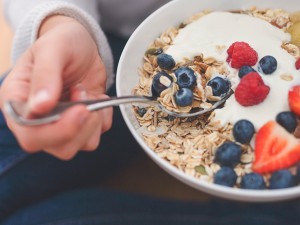
In MMC’s first wellness post for October 2023, the topic of preventative nutrition for breast cancer was explored. In it, MMC’s Stefanie Arblaster, RDN, encouraged readers to eat “a diet rich in color and variety,” a rainbow of fruits and vegetables, if you will. Compounds like carotenoids and phytoestrogens were also referenced as having positive effects on the immune system and reproductive health, respectively, with the latter also influencing hormone-dependent tumors. Where do hormones fit into cancer burden or risk, and how does nutrition help?
Quite simply, “being overweight may cause hormonal changes, so maintaining a healthy weight helps minimize the hormones that can lead to diseases like breast cancer,” says Bethany Say, RD, LDN, CDCES from Meadville Medical Center’s Mind-Body Wellness Center. Studies have shown that excess weight and high body fat levels can affect hormone levels, which in turn has shown to increase the risk of colon, pancreatic, and breast cancer. Increasing your fruit and vegetable intake, as well as exercising for at least thirty minutes, five times every week, is a great place to start with losing or maintaining weight. Other dietary choices to influence nutrition and healthy weight, according to Bethany, are:
- Having only 18 ounces or less of red meat each week (think in terms of the size of your palm or a deck of cards as 3 ounces).
- Keeping alcohol intake to one drink daily for women, and no more than two for men.
- When possible, avoid sugar-sweetened beverages, as these are inflammatory to the body and influence weight gain.
- Be mindful of sodium intake, and be diligent about checking food labels. Sodium, like sugar, is also inflammatory, and intake is higher from processed foods. Aim for 2000-2300 mg per day, or about 600-800 mg per meal.
Restrictions and limitations are often difficult to implement, especially if those changes are viewed in negative terms, not as something to simply moderate as part of a healthy diet. Where does one start with implementing these preventative standards, whether it’s before or after a diagnosis? Create habits by starting small: “choose 1 or 2 recommendations to start, work on those, and add more when you feel confident in creation of new habits from those first 1 or 2 goals,” according to Bethany.
Colors of Health
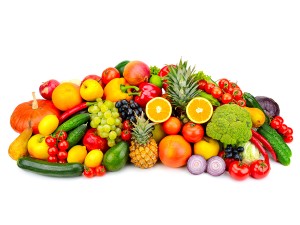
One healthy habit that can always be implemented early on and evolve as we explore different foods (and suggested recipes!) is a variety of colorful foods—that rainbow of fruits and vegetables. Different colors often mean different kinds of nutrients with specific benefits. Fruits and vegetables are also a great source of antioxidants, including beta carotene, lycopene, anthocyanin, and vitamins C and E, all of which fight free radicals that adversely affect the body at a cellular level. The below summary of fruit and vegetables with their corresponding health benefit is also well organized in the this chart from Oldways Nutrition Exchange: What Color Are Your Fruits and Vegetables?
- Green = decrease cancer risk and increase vision health
- Orange/gold = decrease in some types of cancer risk, increase vision health, and decrease inflammation
- Purple/blue = decrease aging, increase memory, decrease cancer risk, increase urinary tract health
- Red = increase heart health, increase memory, decrease cancer risk
- White/tan/brown = increase heart health, decrease cancer risk
Other Important Factors
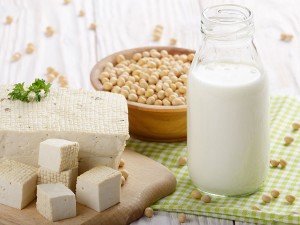
In many cases, the research around breast cancer and nutrition is still ongoing. Perhaps one of the most common questions people have about cancer and safety around certain types of food is on the subject of soy. Soy contains a type of plant estrogen, which is similar in function to human estrogen, although it has weaker effects. While soy contains many other kinds of nutrients, like potassium, magnesium, and protein, its effects on hormone levels vary widely: “I tell [breast cancer] patients to follow the guidance of their oncologist on this topic,” says Bethany Say.
Whereas the pros and cons of soy and its effects on hormones and cancer risk vary widely, nutritional supplements get a firm “no” until concrete research says otherwise: “supplements are not as well regulated in the US as they could be. Companies tout all of these potential benefits, but I’m not aware of a single supplement that has been proven to impact cancer risk,” says Bethany. “However, there is good research showing that breastfeeding [for up to at least 6 months] does decrease the risk of breast cancer!”
Conclusions
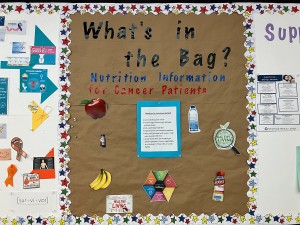
If a good part of this article came across once again as preventative measures, it is because utilizing those initial best practices will help restore health to cancer patients and survivors, and hopefully avoid a recurrence of cancer, or the development of another disease or condition. For those undergoing chemotherapy, the requirements may be slightly different, and should be followed under the guidance of a clinician. For example, chemotherapy and other treatments take a demanding toll on the body. More calories are often burned to keep energy above a certain level, yet side effects, such as nausea, often diminish appetite. One display at MMC’s Yolanda G. Barco Oncology Institute (see photo) advises how cancer patients can maintain good nutrition and energy levels, while avoiding certain foods that might cause discomfort during the treatment process:
- Eat small, frequent meals
- Choose high calorie, high fat, high protein foods
- Eat a well-balanced diet
- Use light exercise to increase appetite
- Stay well hydrated with water, milk, and juice; avoid caffeine
- Avoid foods that are irritating to bowels, e.g. popcorn, fruits, vegetables
- Avoid foods that are irritating to the throat, i.e. dry or acidic foods
Featured Recipes
Meadville Medical Center has discussed nutrition and cancer risk many times over the years! The selected recipes for this blog post come from a 2017 presentation titled, Fighting Cancer with Your Fork, with the goal of incorporating more vegetables and whole grains into one’s diet to reduce cancer risk:
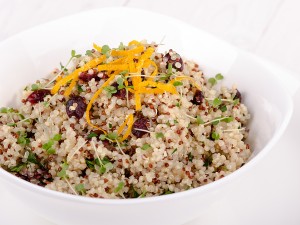
With raisins and toasted almonds
Servings: 6
- 1 cup quinoa
- 1 cup vegetable stock (low sodium)
- 1 cup water
- ¼ cup orange juice
- 2 tablespoons lemon juice
- 2 tablespoons olive oil
- 1 teaspoon Dijon mustard
- 2 teaspoons honey
- 1 tablespoon curry powder
- 2 tablespoons red onion, minced
- ½ cup raisins
- ½ sliced almonds, toasted
Bring the quinoa, vegetable broth, and water to a boil in a saucepan over high heat. Reduce heat to medium-low, cover, and simmer until the quinoa is tender and the water is absorbed, about 15-20 minutes.
While the quinoa is cooking, prepare the dressing by whisking together the orange juice, lemon juice, olive oil, mustard, honey, and curry powder in a mixing bowl. Stir in the cooked quinoa, red onion, and raisins; season to taste with sea salt, Cover, and chill in the refrigerator several hours until cold.
Stir in half of the toasted almonds immediately before serving. Sprinkle the remaining almonds on top and serve.
Per Serving: 275 calories; 13g fat; 7g protein; 36g carbohydrate
Exchanges: 1 ½ grain (starch); ½ lean meat; ½ fruit; 2 ½ fat
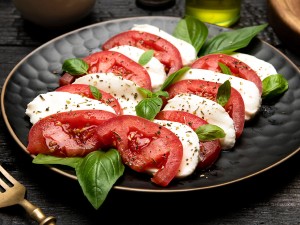
A simple salad of fresh mozzarella and tomatoes topped with basil and a splash of balsamic. A perfect summer appetizer or first course.
Servings: 8
- 1 Large Tomato, sliced
- 8 ounces fresh Mozzarella cheese
- 6 basil leaves, sliced
- 2 teaspoons Olive oil
- 1 teaspoon Balsamic vinegar
Place sliced mozzarella on a large plate or platter. Top with tomatoes, olive oil, balsamic and basil. Served immediately.
Per Serving: 104 Calories; 8 g Fat; 6 g Protein; 1 g Carbohydrate; trace dietary fiber; 25 mg Cholesterol; 119 mg Sodium.
Exchanges: 1 Meat; 1 Fat
Lorem ipsum dolor sit amet, consectetur adipiscing elit. Ut elit tellus, luctus nec ullamcorper mattis, pulvinar dapibus leo.
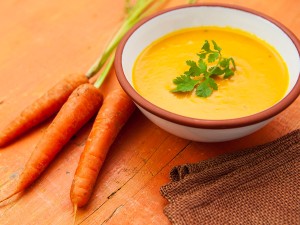
A smooth and creamy soup that is a great way to start off a meal.
Servings: 10
- 3 Tablespoons unsalted butter
- 1 ½ pounds Carrots, peeled and sliced thin
- 2 cups Yellow Onions, chopped
- 1 teaspoon salt
- 1 teaspoon ginger, minced
- 2 cups low sodium chicken broth
- 2 cups water
- 3 large strips orange zest
Melt the butter in a soup pot over medium heat and cook the onions and carrots, stirring occasionally, until the onions soften, about 5 to 8 minutes. Do not let the onions or carrots brown. Sprinkle a teaspoon of salt over the carrots and onions as they cook.
Add the broth, water, ginger and strips of orange zest. Bring to a simmer, cover and cook until the carrots soften, about 20 minutes.
Remove the strips of orange zest and discard. Working in small batches, pour the soup into a blender and puree until completely smooth. Only fill the blender bowl a third full with the hot liquid and keep one hand pressing down the cap of the blender to keep it from popping off. Add more salt to taste.
Garnish with chopped chives, parsley or fennel fronds.
** An immersion blender can be used instead of a blender for processing the soup. You will need to keep working with the soup until it is as smooth as possible.
Per Serving: 81 calories; 4 g fat; 3 g protein; 10 g carbohydrate; 2 g fiber; 9 mg cholesterol; 341 mg sodium
Exchanges: 1 ½ Vegetable; 1 Fat
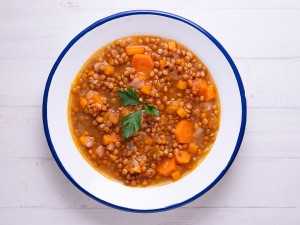
A quick and easy soup. Serve it during the winter. It’s great with warm biscuits or bread.
Servings: 8
Yield: 3 quarts
- 2 carrots, sliced
- 2 celery ribs, sliced
- 1 onion, chopped
- 10 cups water
- 1 package dried lentils, rinsed
- 4 red potatoes, diced
- 2 bay leaves
- 2 teaspoons salt
- 1 teaspoon pepper
In a large nonstick saucepan coated with cooking spray, cook the carrots, celery and onion over medium heat for 5 minutes.
Stir in the water, lentils, potatoes, bay leaves, salt and pepper. Bring to a boil. Reduce heat; cover and simmer for 30 to 35 minutes or until lentils are tender. Discard bay leaves.
Per Serving: 125 calories; minimal fat; 8g protein; 24g carbohydrate; 9g dietary fiber; 0mg cholesterol; 561 mg sodium
Exchanges: 1 ½ grain (starch); ½ lean meat; ½ vegetable
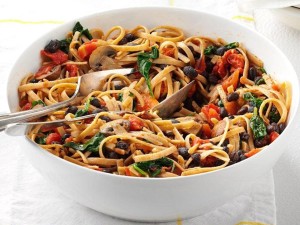
A quick and hearty dish that is full of flavor. Simple and easy to prepare in just 30 minutes.
Servings: 6
- 9 oz. whole wheat fettuccine, uncooked
- 1 Tablespoon Olive Oil
- 1 ¾ cups whole mushrooms, sliced
- 1 clove garlic, minced
- 1 can black beans, rinsed and drained
- 1 can tomatoes, low sodium, diced and undrained
- 1 teaspoon dried rosemary, crushed
- ½ teaspoon oregano
- 2 cups spinach leaves
Cook fettuccine according to package directions. Meanwhile, in a large skillet, heat oil over medium-high heat. Add sliced mushrooms; cook and stir 4 to 6 minutes or until tender. Add garlic; cook 1 minute longer.
Stir in black beans, tomatoes, rosemary and oregano; Heat through. Stir in spinach until wilted. Drain fettuccine; add to bean mixture and toss to combine.
Per Serving: 154 calories; 3g fat; 9g protein; 25g carbohydrate; 6g dietary fiber; 0mg cholesterol; 14 mg sodium
Exchanges: 1 ½ Grain (Starch); ½ Meat; 1 Vegetable; ½ Fat
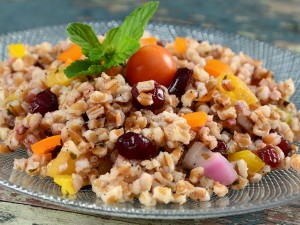
This hearty salad is bursting with harvest flavors and healthful omega-3s.
Servings: 6
- 1 ½ cups wheat berries
- 2 celery ribs, finely chopped
- ½ cup dried cherries, chopped
- ½ cup chopped walnuts, toasted
- ¼ cup minced fresh parsley
- 1 green onion, chopped
- 3 tablespoons Olive oil
- 2 tablespoons lemon juice
- ¼ teaspoon salt
- ¼ teaspoon pepper
- Mixed salad greens, optional
Place wheat berries in a large saucepan; add water to cover by 2 inches. Bring to a boil. Reduce heat; simmer, covered, about 1 hour or until tender. Drain; transfer to a large bowl. Cool completely.
Add celery, cherries, walnuts, parsley and green onion to wheat berries. In a small bowl, whisk oil, lemon juice, salt and pepper until blended; add to salad and toss to coat. If desired, serve over greens.
Per Serving: ½ cup (calculated without salad greens): 215 calories; 9 g fat; 5 g protein; 30 g carbohydrate; 5 g dietary fiber; 0 mg cholesterol; 75 mg sodium
Exchanges: 1 Grain (starch); 1 fruit; 1 fat; ½ Lean Meat


